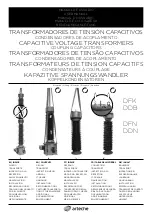
Preliminary Technical
Data
Rev. PrA | Page 22 of 82
Figure 26. DPD Regularization for Decreasing Sensitivity to Sparse Data
For the AM-AM characteristics shown above, the effect of low regularization and optimum regularization on DPD is shown in
Figure 27. With low regularization, the DPD algorithm has a tendency to overfit resulting in high power scattering. With the
optimum regularization, the sensitivity of DPD algorithm to sparse data in high power is minimized.
Figure 27. Effect of DPD Regularization on DPD Stability
The DPD provides user configuration for regularization via adi_adrv9025_DpdModelConfig_t. dpdIndirectRegularizationValue
and adi_adrv9025_DpdModelConfig_t.dpdDirectRegularizationValue for indirect learning and direct learning mechanisms
configured via the adi_adrv9025_DpdTrackingConfigSet() API.
DPD Regularization in DPD Mode 2
For DPD Mode 2 operation where separate pre-distortion coefficients are maintained for low power (C-Table) and high power (M-
Table) data, a separate regularization value can also be applied to low power (C-Table) and high power (M-Table) models. This is
typically intended to be used with GaN PA applications where the PA non-linearity characteristics could vary for low power and
high power signals.
Table 5. DPD Regularization Parameters in DPD Mode 2
Regularization Parameter
Target DPD Actuator Model
adi_adrv9025_DpdModelConfig_t.
dpdIndirectRegularizationValue
M-Table
adi_adrv9025_DpdModelConfig_t.
dpdIndirectRegularizationLowPowerValue
C-Table
NOTE:
Separate low power and high power regularization values are only applicable using the DPD indirect learning mechanism.
















































